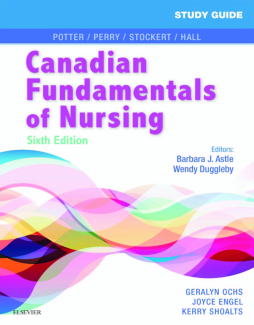
BOOK
Study Guide for Canadian Fundamentals of Nursing - E-Book
Patricia A. Potter | Anne Griffin Perry | Patricia Stockert | Amy Hall | Barbara J. Astle | Wendy Duggleby | Kyla C. Janzen | Geralyn Ochs
(2018)
Additional Information
Book Details
Abstract
Ensure you’re getting the most out of your textbook with this helpful study tool! Corresponding to Canadian Fundamentals of Nursing, Sixth Edition, this study guide helps you master the key nursing concepts with review questions, exercises, and learning activities. In addition, skills performance checklists make it easier to learn and master important nursing procedures.
- Multiple choice review questions help you to evaluate how well you understand key chapter objectives.
- Comprehensive Understanding sections help you master the key topics and main ideas in each chapter.
- Critical Thinking Model exercises help you to apply what you’ve learned in the case studies.
- Preliminary Readings refer you back to the related text chapter.
- NEW! Completely updated content reflects Canadian Fundamentals of Nursing, Sixth Edition.
- New question formats (including matching, fill in the blank, MCQ, etc.).
Table of Contents
| Section Title | Page | Action | Price |
|---|---|---|---|
| Front Cover | Cover | ||
| IFC\r | ES1 | ||
| Canadian Fundamentals of Nursing | i | ||
| Contents | iii | ||
| Introduction | v | ||
| ONE -\rHEALTH AND HEALTH CARE IN CANADA | 1 | ||
| 1 - HEALTH AND WELLNESS | 1 | ||
| 2 - The Canadian Health Care Delivery System | 4 | ||
| 3 - The Development of Nursing in Canada | 7 | ||
| 4 - Community Health Nursing Practice | 10 | ||
| TWO - FOUNDATIONS OF NURSING PRACTICE | 14 | ||
| 5 - Theoretical Foundations of Nursing Practice | 14 | ||
| 6 - Evidence-Informed Practice | 17 | ||
| 7 - Nursing Values and Ethics | 20 | ||
| 8 - Legal Implications in Nursing Practice | 23 | ||
| 9 - Global Health | 27 | ||
| 10 - Indigenous Health | 30 | ||
| 11 - Nursing Leadership, Management, and Collaborative Practice | 33 | ||
| THREE - APPROACHES TO NURSING CARE | 36 | ||
| 12 - Critical Thinking in Nursing Practice | 36 | ||
| 13 - Nursing Assessment, Diagnosis, and Planning | 39 | ||
| 14 - Implementing and Evaluating Nursing Care | 43 | ||
| 15 - Documenting and Reporting | 46 | ||
| 16 - Nursing Informatics and Canadian Nursing Practice | 50 | ||
| FOUR - WORKING WITH PATIENTS AND FAMILIES | 53 | ||
| 17 - Communication and Relational Practice | 53 | ||
| 18 - Patient-Centred Care: Interprofessional Collaborative Practice | 59 | ||
| 19 - Family Nursing | 62 | ||
| 20 - Patient Education | 66 | ||
| FIVE - CARING THROUGHOUT THE LIFESPAN | 71 | ||
| 21 - DEVELOPMENTAL THEORIES | 71 | ||
| 22 - Conception Through Adolescence | 76 | ||
| 23 - Young to Middle Adulthood | 84 | ||
| 24 - Older Persons | 88 | ||
| 25 - The Experience of Loss, Death, and Grief | 93 | ||
| SIX - PSYCHOSOCIAL CONSIDERATIONS | 97 | ||
| 26 - Self-Concept | 97 | ||
| 27 - Sexuality | 102 | ||
| 28 - Spirituality in Health and Health Care | 107 | ||
| 29 - Stress and Adaptation | 111 | ||
| SEVEN - SCIENTIFIC BASIS FOR NURSING PRACTICE | 116 | ||
| 30 - Vital Signs | 116 | ||
| 31 - Pain Assessment and Management | 124 | ||
| 32 - Health Assessment and Physical Examination | 133 | ||
| 33 - Infection Control | 143 | ||
| 34 - Medication Administration | 150 | ||
| 35 - Complementary and Alternative Approaches in Health Care | 164 | ||
| EIGHT - BASIC PHYSIOLOGICAL NEEDS | 168 | ||
| 36 - Activity and Exercise | 168 | ||
| 37 - QUALITY AND PATIENT SAFETY | 174 | ||
| 38 - Hygiene | 179 | ||
| 39 - Cardiopulmonary Functioning and Oxygenation | 188 | ||
| 40 - Fluid, Electrolyte, and Acid–Base Balances | 201 | ||
| 41 - Sleep | 212 | ||
| 42 - Nutrition | 220 | ||
| 43 - Urinary Elimination | 231 | ||
| 44 - Bowel Elimination | 241 | ||
| NINE -\rPATIENTS WITH SPECIAL NEEDS | 251 | ||
| 45 - Mobility and Immobility | 251 | ||
| 46 - Skin Integrity and Wound Care | 257 | ||
| 47 - Sensory Alterations | 265 | ||
| 48 - Care of Surgical Patients | 271 |
